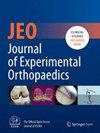Impact of contralateral pelvic drop and femoral adduction on the femoral head acetabular coverage: A study on the reproducibility of a new radiographic measurement method
Abstract
Purpose
Traditional radiographic measurements for acetabular dysplasia and femoroacetabular impingement syndrome (FAIS) are typically done in static positions, overlooking dynamic behaviours. This study investigated the reproducibility of a new radiographic method that incorporates pelvic and femoral motion during running.
Methods
This cross-sectional retrospective study included 10 patients (5 males/5 females; Mean 42.4, SD: 3.0 years) with symptomatic unilateral FAIS. Participants underwent three-dimensional running analysis and standard supine anteroposterior (AP) pelvis radiographs. Using specialised software, the femur and pelvis were rotated in the coronal plane according to peak angles of contralateral pelvic drop and femoral adduction from the running analysis, preserving the original hip joint centre. Two experienced physicians measured the lateral centre edge angle (LCEA), acetabular index (AI), sharp angle (SA), extrusion index (EI), and femoro-epiphyseal acetabular roof index (FEAR INDEX) on both standard and manipulated (M) radiographs in two rounds, with a 15-day interval. Differences between the original and manipulated measurements (VAR) were also calculated. Intra- and inter-rater reliability were assessed using the intraclass correlation coefficient (ICC) and Bland-Altman method, with a significance level of 5%.
Results
The average contralateral pelvic drop and femoral adduction used for image manipulation were 4.7° (SD: 2.7) and 6.2° (SD: 2.4), respectively. Of the 15 radiographic measurements, 14 showed good to excellent inter-rater reliability in the first assessment (range: 0.76-0.98), which decreased to 11 in the second assessment (range: 0.80–0.96). Intra-rater reliability showed 13 and 12 measurements with good or excellent reliability for raters 1 (range: 0.75–0.97) and 2 (range: 0.79–0.97), respectively.
Conclusion
This study demonstrates that incorporating dynamic motion into femoral head acetabular coverage radiographic measurements provides potential reliable assessments for most parameters. Integrating motion analysis with radiography could improve understanding of acetabular coverage in active individuals and support surgical decision-making.
Level of evidence
Diagnostic Study, Level III.


 求助内容:
求助内容: 应助结果提醒方式:
应助结果提醒方式:


